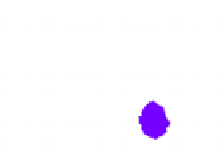Information Technology Reference
In-Depth Information
t
=10
000
t
=40
000
t
= 360
000
Fig. 1.
Snapshots at various iteration times. The domain size is 290
×
200. There are
1500 corpses and 1000 ants. Results reported on the upper and on the lower row are
obtained using probabilistic, respectively deterministic, pick-up.
measurement never yields the value 1 and its maximum value depends on
N
0
. The
maximum density is approximately 1
/
(1+2(
π/N
0
)
1
/
2
)
≈
0
.
92which corresponds
to the case of a disk.
Recall that in our CA model, ants have no idea of the size of the cluster from
which they remove a corpse or to which they add one. Hence on average in the
deterministic case, each cluster is fed and depleted at the same rate, because
ants pick up and deposit bodies symmetrically. However, statistical fluctuations
may cause any cluster to vanish, with a probability inverse to its size. Therefore,
the dynamics is biased towards forming larger clusters until only one remains.
Probabilistic pick-up favors the depletion of non-compact clusters, and therefore
the growth of compact ones. The clustering process appears to be accelerated
towards forming few large compact clusters. However, these big size compact
clusters are very robust. Hence in the end, the algorithm spends a lot of time to
form a single cluster from a few similar size compact clusters.
Real ants are known to preferentially cluster bodies against obstacles. We
thus decided to observe the effect of obstacles in the ant environment. In our
model, we had to adapt the motion rule: an ant colliding into an obstacle simply
reverses its direction. The presence of an obstacle in the simulation arena biases
further the pick-up rule and breaks the spatial symmetry of the ant motion.
In particular, a cluster located against an obstacle is di
A
cult to erode from
that side. Thus, once a cluster builds up against an obstacle, due to statistical
fluctuations, it is likely to stay there forever. However, if during the primary
stage of the clustering process, no cluster is formed against the obstacle, then
the final cluster ends up elsewhere. This occurred in several of our simulations.








